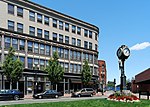Fabens Building

The Fabens Building is a historic commercial building at 312-344 Union Street in Lynn, Massachusetts. The four story brick building was built in 1890, replacing two buildings that were destroyed in Lynn's disastrous 1889 fire. It was built for William Fabens, a Marblehead lawyer and judge who maintained offices in the city and sat on the city police court. The building had seven storefronts on the ground floor, with office space on the upper floors. Designed by local architect Henry Warren Rogers, it is one Lynn's most significant Romanesque Revival buildings.The building was listed on the National Register of Historic Places in 1982, and is one of three registered buildings in Lynn designed by Henry Warren Rogers.
Excerpt from the Wikipedia article Fabens Building (License: CC BY-SA 3.0, Authors, Images).Fabens Building
Union Street, Lynn
Geographical coordinates (GPS) Address Nearby Places Show on map
Geographical coordinates (GPS)
| Latitude | Longitude |
|---|---|
| N 42.464722222222 ° | E -70.943888888889 ° |
Address
Union Street 305;307;309;311
01903 Lynn
Massachusetts, United States
Open on Google Maps










